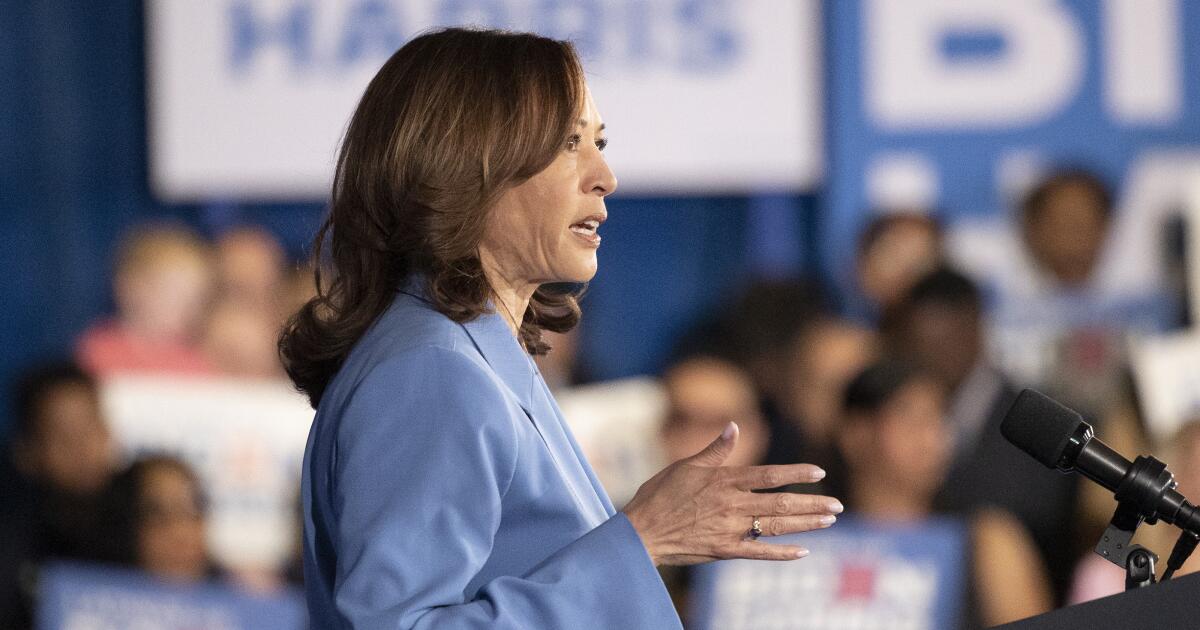Business
Column: Is America cheating its children to subsidize old people? Refuting a common falsehood

Whether it’s because the current partisan environment has us fixated on age in America, or because everyone is seeking an explanation for Americans’ discontent with a growing economy, or for some other reason, an old yarn about a generational war in the country has been making the rounds lately.
Over just the last four weeks, the idea that America is subsidizing its seniors at the expense of future generations has surfaced in the Washington Post (“Why we’re borrowing to fund the elderly while neglecting everyone else”), the Wall Street Journal (“Older Americans Are Better off Than Ever”) and twice in the New York Times (“For the Good of the Country, Older Americans Should Work More and Take Less,” and “Older Americans are Winning the Battle of the Generations”).
It also played a starring role in an exceptionally dumb article about Social Security at Slate.com that I deconstructed just last week. But since it appears in many contexts other than Social Security, and seems fated to become a common meme in the coming presidential election, I think it’s worth a focused examination all its own.
Social Security is not a big subsidy to retirees.
— Economist Dean Baker debunks a common and incorrect claim
Some of the recent articles have been accompanied by illustrations of happy, active seniors at play, presumably at the expense of their children or grandchildren or society at large.
(The New York Times’ illustrations were somewhat more sinister, consisting of artworks depicting lazy, wizened old men allowing themselves heedlessly and heartlessly to be physically carried about by younger people, including children, doubled over from the weight.)
These pieces would be instructive for policy makers, if they were true. But they’re not true.
Rather, they’re all versions of an old meme known as “the undeserving poor,” which has been commonly deployed to imply that the recipients of government assistance are layabouts and malingerers sucking up resources from hardworking taxpayers. In this case, the targets can be defined as “the undeserving old.”
What the most recent screeds tend to have in common is the notion that we spend enormously greater sums on elderly people than on our children, and that it’s an economic choice with inescapable consequences in a fiscal zero-sum game — “the fundamental challenge that clouds our long-term fiscal outlook,” writes Catherine Rampell, the author of the Washington Post’s version.
The subtext is that by monopolizing America’s resources, the powerful seniors’ lobby is depriving our children of sustenance and adequate healthcare. Spending on Social Security and Medicare is the culprit: The cost of entitlements, Rampell writes, “will continue to crowd out future spending obligations in years ahead as the country ages and birthrates fall.”
But that’s completely wrong. What Rampell depicts as a fiscal inevitability is nothing of the kind. The notion that spending on seniors cuts directly into our capacity to spend on children reflects a political choice. It’s a moral test, not an economic one, and one that we consistently fail.
The truth is that America has more than enough resources to meet all its social needs, of all generations. If it has not done so, the reason isn’t that resources are scarce, but that those who wield power in government have chosen to veto spending that benefits children and young people (who, of course, don’t vote).
Let’s examine how this worked recently, using the Child Tax Credit as our laboratory sample.
The credit, which was originally enacted in 1997, was enhanced in 2021 as part of the Biden administration’s American Rescue Plan, a pandemic recovery measure. The American Rescue Plan increased the credit to an annual $3,000 per child ($3,600 for children under age 6), from $2,000. It raised the maximum age of children eligible for the credit to 17 from 16.
The American Rescue Plan also made the credit fully refundable, meaning that it went to families regardless of whether or how much they paid in federal income taxes. The preexisting program’s work incentives, which reduced the credit for lower-income families, were rescinded.
The Congressional Joint Committee on Taxation estimated the annual cost of the enhanced child credit at about $12 billion a year.
Is this an expenditure that the cost of Social Security and Medicare rendered unaffordable? Certainly not in comparison to other things that landed on the federal government’s expense ledger, such as the tax cuts enacted by Republicans for the benefit of corporations and wealthy people.
Their cost has been estimated by the Committee for a Responsible Federal Budget, a billionaire-funded Washington think tank staffed by deficit hawks, at $1.5 trillion over 10 years, or $150 billion a year. If you’re looking for expenditures that crowd out spending on children, you could start and finish right there.
(You can be sure that the commission being launched by House Speaker Mike Johnson (R-La.) to examine the cost of “entitlement” programs will ignore those figures.)
The Child Tax Credit enhancements reduced the child poverty rate in America by almost one-third, to 12.1% by the end of 2021. That worked out to lifting 3.7 million children out of poverty. When Congress failed to extend the enhancements beyond the end of 2021, the child poverty rate jumped up to 17%. (Black and Latino families were hit even harder.)
In other words, the Child Tax Credit had worked exactly as expected. It did so, moreover, without having any measurable effect on inflation.
Yet its purported inflationary impact was among the rationales offered by the credit’s enemy-in-chief, Sen. Joe Manchin III (D-W. Va.), for killing the enhancements. Manchin had other objections, as it happened, but they were all equally specious. They included the absence of work requirements, which as I’ve shown time and again accomplish nothing in terms of raising employment but do make all such programs more expensive to run.
The gap in life expectancy between rich and poor is wide — and has widened sharply in the last 30 years.
(National Academy of Sciences)
Rampell, drawing on statistics developed by C. Eugene Steuerle — who happens to be a co-author of one of the New York Times pieces — wrote in the Washington Post of America’s “seemingly bottomless commitment to add debt on behalf of retirees.” (Social Security, by the way, doesn’t add debt to the federal budget — in fact, it lends money to the government, taking interest-bearing Treasury securities in return.)
Rampell selects as an example a single man who earned the average wage every year of his adult life before retiring in 2020 at age 65, paying about $470,000 in Social Security and Medicare taxes and receiving benefits projected to total $640,000 in retirement — one of the system’s “lucky individuals,” she writes.
According to Steuerle’s figures, however, the “lucky individuals” receiving this subsidy are mostly people at the lower end of the income scale. The projected benefits of those with average lifetime earnings of less than about $66,000 a year in 2023 dollars do exceed the payroll taxes they paid over their lifetimes, though not by much. The single male with average annual lifetime earnings of $66,000 who retired in 2020, for instance, will have paid an estimated $367,000 in Social Security taxes but will receive a projected $383,000 in benefits.
Those with higher lifetime earnings will have paid for their own benefits through payroll taxes, Steuerle shows, and the higher their income, the more they’ve paid. Those with maximum taxable earnings ($160,200 in 2023 dollars) will have paid about 40% more in taxes than they receive in benefits. (Some of the excess will go to cover the little-understood insurance features of Social Security — its disability and dependent coverages.)
In other words, as economist Dean Baker of the Center for Economic and Policy Research observes, these figures demonstrate that, contrary to the generational war hype, by Steuerle’s calculations young people are not really paying for the benefits of their elders. “Social Security is not a big subsidy to retirees,” he says. The working poor receive a subsidy, but would anyone really call them “lucky”? The truly fortunate in our society are paying for their own Social Security benefits.
It’s true that retirees typically receive more in Medicare benefits than they have paid for through the payroll tax. But that’s the direct result of America’s failure to get a grip on per capita healthcare costs, which run (unnecessarily) at more than twice the average of all developed countries. That’s a political choice, too — the choice by lawmakers unwilling to get off their duffs to bring those costs under control, say, by capping prescription drug prices.
All this should provide some context to the constant drumbeat from budget conservatives that we’ll need to cut benefits to keep Social Security afloat. As Baker points out, cutting the Social Security “subsidy” would mean reducing benefits for those with average lifetime earnings below $66,000. No one in that category is living what most people would consider a carefree life.
They’re certainly not in the category of retirees who, as Steuerle described them in his New York Times op-ed, “live independently, play golf or pickleball daily and travel far and wide.”
That brings us to another point about one of the most commonly mentioned “solutions” to the consequences of the supposed generational war: raising the retirement age.
Former South Carolina Gov. Nikki Haley, currently running for second place in the GOP presidential nomination sweepstakes, emitted a fire hose of misconceptions and lies in an appearance on Bloomberg News in August, starting with the assertion that Social Security and Medicare are heading for bankruptcy, which is completely untrue.
She went on to suggest that “we change retirement age to reflect life expectancy….What we do know is 65 is way too low.”
Actually, the Social Security full retirement age is not 65. For those reaching age 64 this year, it’s 66 and 10 months, and for those 63 and younger, it’s 67 — dates that were set in 1983, which should have given Haley enough time to get up to speed. Anyone can start collecting at age 62, but only by taking a haircut of nearly 30% in annual benefits.
More to the point, life expectancy is a moving target, varying by race, educational attainment and income. Indeed, new figures from the National Academy of Sciences show a dramatic effect from the last of those metrics. Among people born in 1960, those in the lowest 20% of income earners — households earning $28,000 or less — males reaching age 50 could expect on average to live to age 76 and females to age 78.
Among those in the highest 20% of earners — households with about $150,000 in average earnings — life expectancy for those reaching age 50 is nearly 89 for males and 92 for females. The gap has widened considerably over the last 30 years, the National Academy of Sciences found.
Does Haley know of a way to make increases in the retirement age more equitable, given these circumstances? One would doubt it, since she also told Bloomberg that “instead of cost-of-living increases, we do it based on inflation.” Um, Ms. Haley, cost-of-living increases are based on inflation.
The bottom line is that all this talk of generational war is a diversion, aimed at obscuring what really accounts for inequality in our economic system. It’s not the young versus the old, but the rich versus all the rest, a battle in which the 1%, determined to hold on to all that they have, convince the 99% by distracting them with talk of “generational war.”
As long as politicians and the press buy this act and sell it to the public, the rich will be winning.

Business
'It Ends With Us' movie banned in Qatar for kissing scenes

Sony Pictures’ hit film adaptation of “It Ends With Us” has been prohibited from screening in Qatar, the Los Angeles Times confirmed Monday.
The country’s censorship committee rejected the PG-13 movie over kissing scenes, according to a person with knowledge of the matter who was not authorized to comment.
Films that have previously been banned in Qatar include “Eternals,” “Doctor Strange in the Multiverse of Madness,” “Spider-Man: Across the Spider-Verse,” “Lightyear” and “West Side Story,” all of which contain LGBTQ+ characters or themes.
Based on the bestselling romance novel by Colleen Hoover, “It Ends With Us” opened in theaters worldwide and collected $80 million over the weekend, including a better than expected $50 million in the U.S. and Canada.
The film stars Blake Lively as a flower shop owner who gets caught in a love triangle with her abusive partner and her childhood sweetheart. Rounding out the main cast are Brandon Sklenar, Jenny Slate and Justin Baldoni, who also directed the picture.
The highly anticipated title garnered mixed reviews from critics but exceeded early expectations at the box office, notably rivaling Marvel’s “Deadpool & Wolverine” starring Lively’s husband, Ryan Reynolds.
Despite its exclusion from Qatar, nearly 40% of the opening-weekend gross for “It Ends With Us” came from international markets. The movie was released in 42 different regions on more than 7,300 screens, according to measurement firm Comscore.
Business
Column: Trump says Harris stole his idea for exempting tips from tax, but her version beats his

Every four years, the just-toss-an-idea-out-there phase of the presidential race precedes the serious campaigning that starts after Labor Day.
The flavor of the moment is the idea of exempting tips from federal taxes. Donald Trump proposed it during an appearance in June in Las Vegas (home to a lot of restaurant and hotel workers who depend on tips).
Kamala Harris offered her version a few days ago during a rally of her own, also in Las Vegas. That prompted Trump to whine on social media that she had poached his idea.
A meaningful share of tipped workers already pay zero federal income tax.
— Ernie Tedeschi, Yale Budget Lab
Are you tired of this yet?
Hang on, because there’s more to say, starting with the fact that a tax exemption for tips on its own won’t do much good for the many low-income workers who count tips as an important part of their income.
Second, this is hardly a new idea — it has been kicking around the political world since at least the 1980s. California exempted tips from state tax (with some conditions) in 2015.
A tax exemption for tips is a crowd-pleaser, but doesn’t stand up to scrutiny. Trump’s version, and a bill introduced by Sen. Ted Cruz (R-Texas) and Rep. Byron Donalds (R-Fla.) to put meat on its bones, are half-baked.
Harris paired hers with a proposal to raise the federal minimum wage, which is a much better policy.
If all this jockeying is the two parties vying to be more family-friendly, the crown goes to the Democrats, hands down.
Let’s place the issue under a microscope.
Since Trump hasn’t given any details, we have to use the Cruz/Donalds No Tax on Tips Act as a signpost for the GOP approach. The measure exempts tips from federal income tax, but not from the payroll tax that funds Social Security and part of Medicare. It applies only to households that pay federal income taxes — it’s not refundable, meaning that it doesn’t provide any benefit to households whose income is so low they don’t owe federal taxes.
That leaves out all but “a small sliver” of American workers, according to economist Ernie Tedeschi of the Yale Budget Lab. He counts the number of workers in traditional tipped occupations, including wait staff, barbers and hairdressers, at about 4 million, or just 2.5% of all workers.
“A meaningful share of tipped workers already pay zero federal income tax,” Tedeschi notes.
U.S. census data drive home his point: More than a third of tipped workers earned so little in 2022 that they owed no federal income tax. In other words, they’d receive zero benefit from the Republican act.
Another flaw of the bill is its lack of guardrails to ensure that only low-income tipped workers receive its benefits. Nowhere in the three-page measure are tips defined, nor is there a phase-out of the tax break based on income. This raises the possibility that higher-income households could game the system by defining some of their earnings as tips and pocketing the deduction.
Nothing would “prevent high-income professionals such as hedge fund managers from shifting their compensation to a tax-free tipping model,” observes Brendan Duke of the liberal Center for American Progress.
That mention of “hedge fund managers” shows that the folks at CAP know how their audience would react to another giveaway to plutocrats, but it’s hard to deny that the wealthy are masters of exploiting any tax break that could conceivably save them money.
The biggest problem with the Republican approach is that it operates in a vacuum, as if exempting tips from income tax is all that needs to be done to vest the GOP with pro-family cred. It’s not. Far more gains would be achieved by extending enhancements to the Earned Income Tax Credit and the Child Tax Credit that were enacted as part of the American Rescue Plan of 2021.
The EITC and Child Tax Credit enhancements expired at the end of 2021. Efforts by the Biden White House and its Democratic allies on Capitol Hill to extend them failed, due mostly to Republican opposition. Under the Rescue Plan, the child tax credit was increased to an annual $3,000 per child ($3,600 for children under age 6), from $2,000 per child. The measure raised the maximum age of children eligible for the credit to 17 from 16.
Even more important, the credit was made fully refundable, meaning that it went to families regardless of whether or how much they paid in federal income taxes. The American Rescue Plan also eliminated the preexisting program’s work incentives, which reduced the credit for lower-income families. When the enhancements expired, the child credit fell back to $2,000 per child and reduced the refundable portion to $1,700.
As CAP calculates, many of the low-income households that would receive nothing from the No Tax on Tips Act — a single parent with one child, living on $24,000 income mostly from tips, a student working part-time or a married couple earning less than $30,000 — would receive benefits of up to $2,600 from restoration of the American Rescue Plan credits.
The enhanced Child Tax Credit reduced the child poverty rate by about 30%, keeping as many as 3.7 million children out of poverty by the end of 2021. When the enhancements expired in January, the child poverty rate spiked to 17% from 12.1%, plunging 3.7 million children back under the poverty line. The impact was much worse on Black, Latino and Asian children than on white ones.
In other words, if the Republicans wished to be pro-family really, not just rhetorically, they would have clamored to extend the credits.
Trump’s running mate, JD Vance, whose mouth writes checks his campaign can’t cash, says he’s in favor of the child tax credit and even wants to raise it as high as $5,000 per child. Couple of problems here: First, he surely knows that his Republican colleagues in Congress would never support such a large grant to families, and second, when a more modest increase came up to the Senate floor two weeks ago, Vance didn’t even show up to vote.
How about Harris’ proposal?
What she said in Las Vegas was this: “We will continue our fight for working families of America, including to raise the minimum wage and eliminate taxes on tips for service and hospitality workers.” Nestled within that statement are two very important distinctions from the Trump or Republican proposal.
First is a raise in the federal minimum wage, which has been frozen at $7.25 an hour since 2009. Had the minimum kept pace with inflation, it would be $10.79 today. In seven states, the federal wage applies — five that have not enacted a minimum wage of their own (Alabama, Louisiana, Mississippi, South Carolina and Tennessee) and two (Georgia and Wyoming) where the state minimum is lower than $7.25, meaning that the federal wage is the law.
Harris also specified service and hospitality workers, which obviously means she would exclude professionals gaming the law. Whether she would do so by phasing out the benefit by income or specifically identifying eligible occupations isn’t clear.
Despite her careful phrasing, conservative commentators and not a few actual journalistic organizations fell into the trap of treating Harris’ proposal as a copycat of Trump’s.
The right-wing pundit Mary Katherine Ham, whose determination to tell it like it is was hampered by her lack of knowledge, tweeted that if Harris is “just gonna copy and paste Trump’s site, she doesn’t need another week or two to debut it.”
Obviously, if Ham spent two minutes examining the proposals, she wouldn’t have made this claim. But her error matched those of, for example, CBS News, which reported in headline syntax that Harris was “echoing Trump proposal.”
The distinction was also lost on the Wall Street Journal, which accused Harris of “borrowing a Trump idea.” Never mind that the idea wasn’t Trump’s in the first place. The Times, I’m sorry to say, picked up an Associated Press account that described Harris as “echoing a pledge that her opponent, Republican Donald Trump, has made, and marking a rare instance of political overlap from both sides.”
Budget deficit hawks have also weighed in. The Committee for a Responsible Federal Budget, a watchdog group that is an offspring of the late hedge fund billionaire Pete Peterson, wrung its hands over the potential cost of Harris’ plan, based on a conjecture that she would raise the minimum wage to $15 an hour.
The committee estimated that, combined with an income tax exemption, her plan would cost the federal government as much as $200 billion over 10 years. Is that a lot?
The Congressional Budget Office projects that annual federal budgets will total about $19.6 trillion over the next 10 years, making the cost of the minimum wage and tip exemption come to about 1% of federal outlays during that time.
You make the call. Two of the most expensive tax breaks in federal law are the exemptions for contributions and earnings for pension and individual retirement accounts, and the preferential tax rates on dividends and capital gains. Both disproportionately benefit the wealthy. Combined, they come to $680 billion a year; the minimum wage increase and tip exemption would cost an average $20 billion a year.
Some people might think that an important goal of the federal government should be providing for the most vulnerable members of society. The current system, especially after a massive tax break was enacted by the Republicans and signed by Trump in 2017, is heavily skewed toward comforting the wealthy.
If the parties and their candidates want to play the pro-family card, one can’t really blame them for seizing on a policy that sounds great on TV. Only one of the parties has gone beyond a tax exemption on tips and has favored truly comprehensive pro-family policies. Can you see which one?
Business
Hackers may have stolen the Social Security numbers of every American. How to protect yourself

About four months after a notorious hacking group claimed to have stolen an extraordinary amount of sensitive personal information from a major data broker, a member of the group has reportedly released most of it for free on an online marketplace for stolen personal data.
The breach, which includes Social Security numbers and other sensitive data, could power a raft of identity theft, fraud and other crimes, said Teresa Murray, consumer watchdog director for the U.S. Public Information Research Group.
“If this in fact is pretty much the whole dossier on all of us, it certainly is much more concerning” than prior breaches, Murray said in an interview. “And if people weren’t taking precautions in the past, which they should have been doing, this should be a five-alarm wake-up call for them.”
According to a class-action lawsuit filed in U.S. District Court in Fort Lauderdale, Fla., the hacking group USDoD claimed in April to have stolen personal records of 2.9 billion people from National Public Data, which offers personal information to employers, private investigators, staffing agencies and others doing background checks. The group offered in a forum for hackers to sell the data, which included records from the United States, Canada and the United Kingdom, for $3.5 million, a cybersecurity expert said in a post on X.
The lawsuit was reported by Bloomberg Law.
Last week, a purported member of USDoD identified only as Felice told the hacking forum that they were offering “the full NPD database,” according to a screenshot taken by BleepingComputer. The information consists of about 2.7 billion records, each of which includes a person’s full name, address, date of birth, Social Security number and phone number, along with alternate names and birth dates, Felice claimed.
National Public Data didn’t respond to a request for comment, nor has it formally notified people about the alleged breach. It has, however, been telling people who contacted it via email that “we are aware of certain third-party claims about consumer data and are investigating these issues.”
In that email, the company also said that it had “purged the entire database, as a whole, of any and all entries, essentially opting everyone out.” As a result, it said, it has deleted any “non-public personal information” about people, although it added, “We may be required to retain certain records to comply with legal obligations.”
Several news outlets that focus on cybersecurity have looked at portions of the data Felice offered and said they appear to be real people’s actual information. If the leaked material is it what it’s claimed to be, here are some of the risks posed and the steps you can take to protect yourself.
The threat of ID theft
The leak purports to provide much of the information that banks, insurance companies and service providers seek when creating accounts — and when granting a request to change the password on an existing account.
A few key pieces appeared to be missing from the hackers’ haul. One is email addresses, which many people use to log on to services. Another is driver’s license or passport photos, which some governmental agencies rely on to verify identities.
Still, Murray of PIRG said that bad actors could do “all kinds of things” with the leaked information, the most worrisome probably being to try to take over someone’s accounts — including those associated with their bank, investments, insurance policies and email. With your name, Social Security number, date of birth and mailing address, a fraudster could create fake accounts in your name or try to talk someone into resetting the password on one of your existing accounts.
“For somebody who’s really suave at it,” Murray said, “the possibilities are really endless.”
It’s also possible that criminals could use information from previous data breaches to add email addresses to the data from the reported National Public Data leak. Armed with all that, Murray said, “you can cause all kinds of chaos, commit all kinds of crimes, steal all kinds of money.”
How to protect yourself
Data breaches have been so common over the years, some security experts say sensitive information about you is almost certainly available in the dark corners of the internet. And there are a lot of people capable of finding it; VPNRanks, a website that rates virtual private network services, estimates that 5 million people a day will access the dark web through the anonymizing TOR browser, although only a portion of them will be up to no good.
If you suspect that your Social Security number or other important identifying information about you has been leaked, experts say you should put a freeze on your credit files at the three major credit bureaus, Experian, Equifax and TransUnion. You can do so for free, and it will prevent criminals from taking out loans, signing up for credit cards and opening financial accounts under your name. The catch is that you’ll need to remember to lift the freeze temporarily if you are obtaining or applying for something that requires a credit check.
Placing a freeze can be done online or by phone, working with each credit bureau individually. PIRG cautions never to do so in response to an unsolicited email or text purporting to be from one of the credit agencies — such a message is probably the work of a scammer trying to dupe you into revealing sensitive personal information.
For more details, check out PIRG’s step-by-step guide to credit freezes.
You can also sign up for a service that monitors your accounts and the dark web to guard against identity theft, typically for a fee. If your data is exposed in a breach, the company whose network was breached will often provide one of these services for free for a year or more.
As important as these steps are to stop people from opening new accounts in your name, they aren’t much help protecting your existing accounts. Oddly enough, those accounts are especially vulnerable to identity thieves if you haven’t signed up for online access to them, Murray said — that’s because it’s easier for thieves to create a login and password while pretending to be you than it is for them to crack your existing login and password.
Of course, having strong passwords that are different for every service and changed periodically helps. Password manager apps offer a simple way to create and keep track of passwords by storing them in the cloud, essentially requiring you to remember one master password instead of dozens of long and unpronounceable ones. These are available both for free (such as Apple’s iCloud Keychain) and for a fee.
Beyond that, experts say it’s extremely important to sign up for two-factor authentication. That adds another layer of security on top of your login and password. The second factor is usually something sent or linked to your phone, such as a text message; a more secure approach is to use an authenticator app, which will keep you secure even if your phone number is hijacked by scammers.
Yes, scammers can hijack your phone number through techniques called SIM swaps and port-out fraud, causing more identity-theft nightmares. To protect you on that front, AT&T allows you to create a passcode restricting access to your account; T-Mobile offers optional protection against your phone number being switched to a new device, and Verizon automatically blocks SIM swaps by shutting down both the new device and the existing one until the account holder weighs in with the existing device.
Your worst enemy may be you
As much or more than hacked data, scammers also rely on people to reveal sensitive information about themselves. One common tactic is to pose as your bank, employer, phone company or other service provider with whom you’ve done business and then try to hook you with a text or email message.
Banks, for example, routinely tell customers that they will not ask for their account information by phone. Nevertheless, scammers have coaxed victims into providing their account numbers, logins and passwords by posing as bank security officers trying to stop an unauthorized withdrawal or some other supposedly urgent threat.
People may even get an official-looking email purportedly from National Public Data, offering to help them deal with the reported leak, Murray said. “It’s not going to be NPD trying to help. It’s going to be some bad guy overseas” trying to con them out of sensitive information, she said.
It’s a good rule of thumb never to click on a link or call a phone number in an unsolicited text or email. If the message warns about fraud on your account and you don’t want to simply ignore it, look up the phone number for that company’s fraud department (it’s on the back of your debit and credit cards) and call for guidance.
“These bad guys, this is what they do for a living,” Murray said. They might send out tens of thousands of queries and get only one response, but that response could net them $10,000 from an unwitting victim. “Ten thousand dollars in one day for having one hit with one victim, that’s a pretty good return on investment,” she said. “That’s what motivates them.”
-

 Movie Reviews1 week ago
Movie Reviews1 week agoTwisters movie review: no winds of change blowing here – FlickFilosopher.com
-
News1 week ago
The ‘Blue Walz’: How a low-key Midwestern governor shot to the top to be Harris’ VP pick | CNN Politics
-

 Politics1 week ago
Politics1 week agoMark Kelly posts cryptic message amid Kamala Harris veepstakes speculation
-

 News1 week ago
News1 week agoKamala Harris holding rally in Pennsylvania to introduce running mate after securing Democratic nomination
-

 World1 week ago
World1 week agoVenezuela launches probe against opposition leaders Gonzalez, Machado
-

 Politics1 week ago
Politics1 week agoHarris VP search comes down to the wire, with Dems divided over Shapiro, Walz, Kelly
-

 World1 week ago
World1 week agoAt Israel’s ‘Guantanamo Bay’, protesters defend soldiers accused of abuse
-

 World1 week ago
World1 week agoEU Commissioner and RAI top management: A sticky August for Meloni




:quality(70)/cloudfront-us-east-1.images.arcpublishing.com/adn/KCSPFHEX4FGZBNDAGQUZBGRC7U.jpg)










